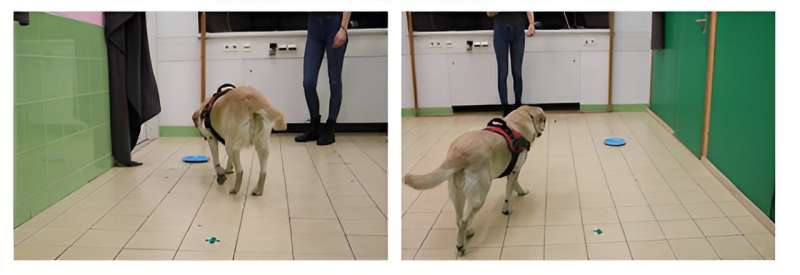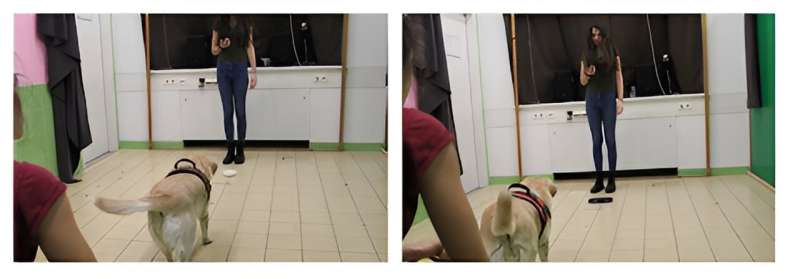This article has been reviewed according to Science X's editorial process and policies. Editors have highlighted the following attributes while ensuring the content's credibility:
fact-checked
trusted source
proofread
The way dogs see the world: Objects are more salient to smarter dogs

When we point at an object, the toddler focuses on the object, while the dog usually takes the gesture as a directional cue.
In a recent study, researchers from the Department of Ethology at Eötvös Loránd University find explanations for this phenomenon. It appears that the discrepancy is not only due to how dogs see, but may, in fact, reflect how they think. For "smarter" dogs, the appearance of an object matters as much as its location, suggesting that their information processing is more similar to that of humans.
Spatial bias is the phenomenon of interpreting information in relation to space, location or distance when the same information could easily apply to an object.
"This is manifested, for example, in the way dogs and children react to gestures when we show them the position of an object. Very early on, children interpret the gesture as pointing to the object, while dogs take the pointing as a directional cue. In other words, regardless of the intention of the person giving the cue, the meaning for children and dogs is different," said Ivaylo Iotchev, first author of the study published in the journal Ethology.
"This phenomenon has previously been observed in dogs using a variety of behavioral tests, ranging from simple associative learning to imitation, but it had never been studied per se."
The researchers have concluded that the spatial bias is an untapped opportunity to better understand how dogs think.
Previous research has not clarified whether dogs behave this way because they have inferior vision compared to primates, or whether it is actually an information processing bias, whereby the parameters of the space around them are more important to dogs than the specific, nearby objects.
The researchers measured spatial bias in two behavioral tests involving 82 dogs. In one task, the dogs had to learn, over a maximum of 50 trials, whether the treat was always on the right or left plate, so they learned a location.
In the other task, two types of plates were used, a white round one and a black square one, these were always placed in the middle. A dog was always given only one type of plate to eat from but was exposed to each in a semi-random sequence. In this constellation, they were learning about the properties of the plate. Learning was measured by how fast a dog ran to the correct plate.
The results showed that the animals learned faster when the treat was placed to the right or left, so they had to choose which direction to go. They had more difficulty remembering whether the treat was on the white round or black square plate. The "spatial bias" measure described how much faster the dogs were at learning about the place than at learning about object features.
A more complicated task followed if the dogs had already learned where the treat was because then the situation was reversed. That is, if they had previously received the treat on the right, it was now on the left in the new position, and if it had been on the white plate, it was now on the black plate.
To find out whether spatial bias is sensory, cognitive or mixed, the researchers needed to detect and measure differences between the visual and cognitive abilities of dogs.

This involved measuring how short the dog's head is—as this is correlated with visual acuity—and also measuring how efficiently they solve problem tasks.
The head shape was investigated by Zsófia Bognár Ph.D. student and co-author of the study.
"The visual abilities of dog breeds differ from each other, which indirectly results from their head shape. Dogs with shorter heads—scientifically known as brachycephalic—develop human-like vision. The structure of their retina implies sharper and more focused vision than their longer-headed counterparts. This has allowed us to use a measure of head shape (the so-called cephalic index) as an approximate measure of the quality of vision in dogs. It is calculated by dividing the width of the skull by the length of the skull. The shorter the head, the higher the number," explained Zsófia Bognár.
To measure cognitive ability, the dogs took part in a series of tests. "We tested their memory, attention skills and perseverance. We found that dogs with better cognitive performance in the more difficult spatial bias task linked information to objects as easily as to places. We also see that as children develop, spatial bias decreases with increasing intelligence," added Eniko Kubinyi, head of the MTA- 'Lendület' Momentum Companion Animal Research Group.
The study found that spatial bias is smaller in dogs with better visual acuity and who are "smarter." "Spatial bias in dogs is not simply a sensory problem but also a mindset. We also found that 'smarter' dogs are resilient in difficult learning situations and can overcome their biases," said Iotchev.
More information: Ivaylo Iotchev et al, Cognitive and sensory capacity each contribute to the canine spatial bias, Ethology (2023). DOI: 10.1111/eth.13423
Provided by Eötvös Loránd University





















